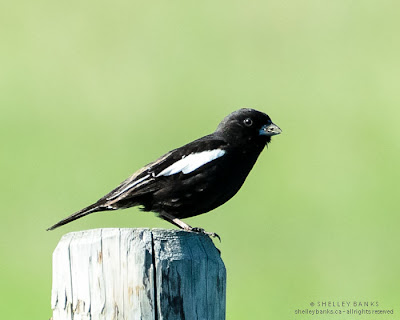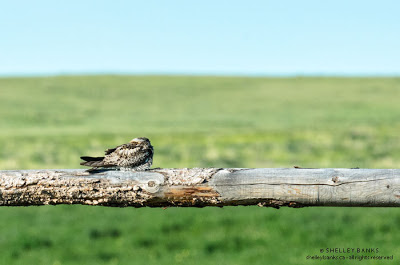 |
| Bobolink on a stalk of dock... How much farther away could it be? © SB |
But so far, they've eluded me, and I see them only when I'm a passenger in a fast car, or they are far off in twilight marshes or deep into atmospherically distorted distant reeds.
A recent trip to Grasslands National Park continued that pattern: When Bobolinks landed, they landed far from me.
I become more interested in Bobolinks on that trip when I learned that these songbirds are among those that migrate annually between North and South America... (Yes, the same population, the exact same birds, share the ribbons of grasses that stretch along our hemisphere.)
And while we see them in Saskatchewan as fairly solitary birds in dramatic black, white and yellow breeding plumage, in Paraguay, Bobolinks appear in massive flocks of brown-sparrow-striped birds in drab winter camouflage.
 |
| Crop of the Bobolink picture © SB |
"The Bobolink is amazing because of the colour — it is completely different here," says Dr. Alberto Yanosky, the biologist who heads Guyra Paraguay, that country’s leading organization for biodiversity research and conservation. (It's also a Birdlife International affiliate.) "You may very easily say that they are different species, but they are the same."
Yanosky, recently named the 2013 Latin American winner of the National Geographic Society/Buffett Award for Leadership in Conservation, was in Saskatchewan for the June Prairie Passages Tour of our publicly owned grasslands.
"We say that they decided to breed here, but they are our birds, that we lend them to you," he says. "And you think that it is on the other side, that they are your birds, and they go south to avoid winter here."
I'm happy to share the Bobolinks and our other grassland birds including Swainson's Hawks, Upland Sandpipers, Common Nighthawks and Wilson's Phalaropes ... I only wish they would land closer to my camera!
What is this bird? A male Bobolink, in breeding plumage.
Location: Grasslands National Park, Saskatchewan, Canada Prairie Passages Tour
Photo date: June 25, 2013.
~~~~~





























